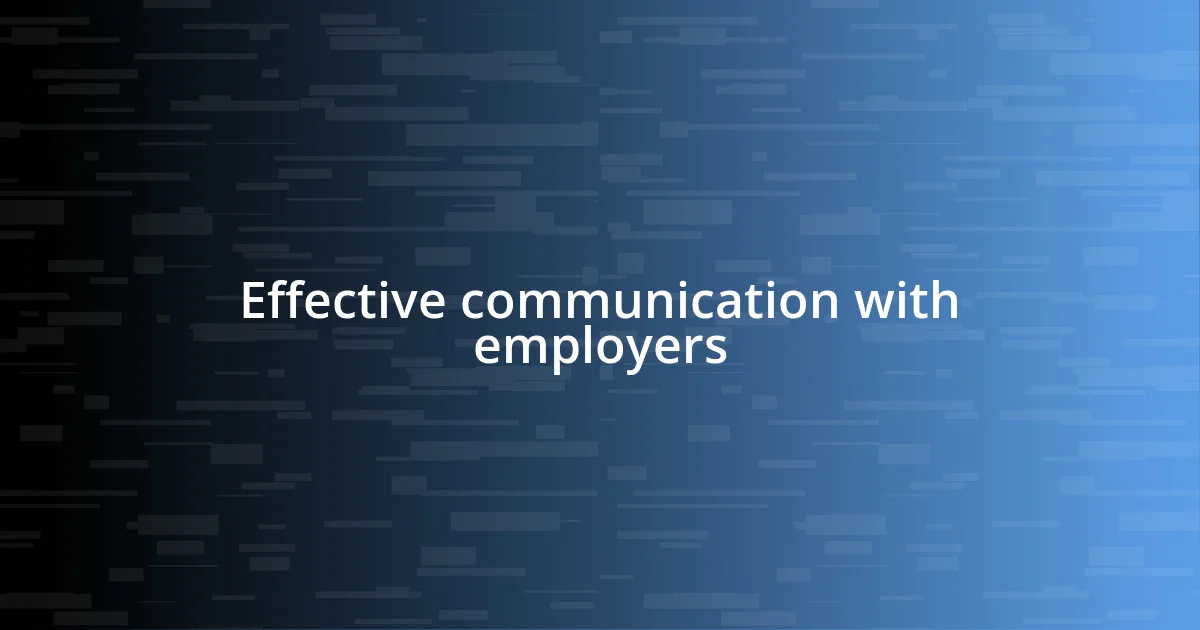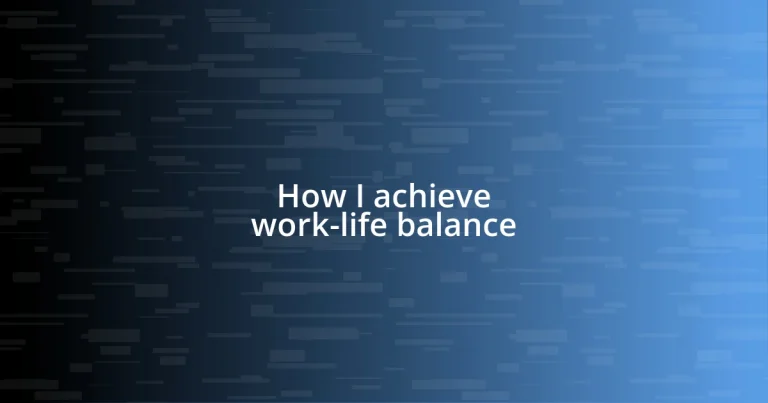Key takeaways:
- Achieving work-life balance involves setting boundaries, recognizing limits, and prioritizing personal well-being to enhance productivity and presence in both work and personal life.
- Implementing effective time management strategies, such as the Pomodoro Technique and the Eisenhower Matrix, helps to maintain focus, reduce overwhelm, and improve overall efficiency.
- Open communication with employers fosters a supportive work environment, allowing for flexibility and understanding regarding individual needs and workloads.

Understanding work-life balance
Understanding work-life balance is more than just dividing hours between work and personal time; it’s about harmonizing responsibilities and passions. I remember a time when I was constantly working late—I was chasing deadlines and trying to impress my boss. Yet, each late night left me worn out and missing important family events. How can we really succeed if we’re missing the moments that matter most?
To me, achieving work-life balance means recognizing my limits and making conscious choices. I had to learn to say no to unnecessary commitments. This was challenging at first, but I found that setting boundaries actually made me more productive. Have you noticed how much clearer your mind feels when you step away from your desk for just a bit?
It’s also about flexibility and finding what works best for you. For some, this might mean dedicating specific hours for work and others for personal projects, while for others, it could be something more fluid. I’ve toyed with this idea, and embracing flexibility helped me appreciate the little victories in my day, whether it’s enjoying a morning coffee without rush or indulging in a good book after a long day. Doesn’t that sound refreshing?

Importance of setting boundaries
Setting boundaries is essential for maintaining a healthy work-life balance. I learned this the hard way when I found myself answering work emails during dinner. It felt like I was always “on,” and I was constantly distracted from meaningful conversations with my family. The moment I decided to put my phone away during meals was a game-changer. Not only did my dinners become more enjoyable, but I also felt more present in my life.
When I finally established clear boundaries with my work schedule, the improvement was evident. I made it a rule to work only during set hours, and this helped me regain my focus and energy. I remember a particularly hectic week where I resisted the urge to work late. By prioritizing my downtime, I was able to recharge and tackle tasks with renewed vigor the next day. Have you ever noticed how much clearer your mind feels when you take proper breaks?
In addition to personal wellbeing, setting boundaries fosters respect both at home and in the workplace. When colleagues see you honoring your time, they are more likely to do the same. One Friday, I decided to leave work exactly at 5 PM. It surprised my team, but it also encouraged them to prioritize their own time. I felt a sense of empowerment in that decision, knowing that I was not only protecting my space but also encouraging a culture of respect. Don’t you think boundaries can lead to healthier work environments?
| Boundaries | Without Boundaries |
|---|---|
| Improved focus | Frequent distractions |
| More quality time | Less personal connection |
| Greater respect | Potential burnout |

Strategies for time management
Time management strategies have been pivotal in my journey toward achieving a balanced life. One of the techniques that transformed my workflow was the Pomodoro Technique. By breaking my work into focused intervals—typically 25 minutes—followed by a short break, I found that I could sustain my energy levels. I remember when I first tried this method; after just a few cycles, I felt a noticeable boost in my productivity and creativity. It was as if I discovered a hidden reservoir of energy I didn’t know I had.
Another approach I’ve embraced is prioritizing tasks with the Eisenhower Matrix. I categorize tasks based on urgency and importance, which helps eliminate the feeling of being overwhelmed. I often ask myself, “Is this task urgent and important?” If the answer isn’t a resounding yes, it tends to find itself on the back burner. This prioritization keeps my mind clear and focused. When I implemented this strategy, I experienced fewer late nights and missed deadlines, enabling me to enjoy time with my loved ones without distractions.
- Set Specific Time Blocks: Designate certain hours for specific activities, enhancing productivity by reducing decision fatigue.
- Create a Daily To-Do List: Write down what you aim to achieve each day, helping visually track your progress.
- Limit Multitasking: Focus on one task at a time; I’ve found it drastically increases my efficiency.
- Use Digital Tools: Leverage apps for reminders and scheduling; they’ve been lifesavers in keeping my commitments organized.
- Reflect and Adjust: At week’s end, I review my time management strategies and make adjustments where needed to continuously improve.

Prioritizing personal well-being
Prioritizing personal well-being is something that I cannot stress enough. I remember a time when I pushed self-care aside, thinking it was a luxury. It wasn’t until I found myself feeling drained and irritable that I realized how crucial it was to prioritize my mental and physical health. Now, I make a conscious effort to incorporate activities that recharge me, like going for a run or indulging in a good book. Have you ever noticed how much better you feel after a moment of quiet reflection?
One practice that has greatly improved my well-being is setting aside “me time” in my calendar each week. This isn’t just about leisure; it’s a dedicated period for nurturing my interests. I once blocked out a couple of hours every Saturday morning to paint, something I hadn’t done in years. It reignited my passion and left me feeling accomplished and more relaxed. What would you do if you carved out time just for yourself?
I firmly believe that emotional well-being goes hand in hand with physical activities. For me, yoga has been a transformative practice that aids in grounding myself. I remember a particularly stressful day when I stepped onto my mat for a quick session, and by the end, I felt like a weight had been lifted. The clarity and peace I found were profound. How often do you allow yourself the space to reconnect with your body and mind? These moments of pause are vital for fostering a balanced life.

Effective communication with employers
Effective communication with employers plays a crucial role in achieving work-life balance. I used to tiptoe around my needs, thinking it would show weakness. However, when I decided to have an open conversation with my manager about my workload and boundaries, I was met with unexpected understanding. Have you ever hesitated to speak up and later wished you had?
By clearly expressing my needs, I noticed a shift in how my employer viewed our working relationship. I began to schedule regular check-ins, and suddenly, my workplace transformed into one where dialogue was encouraged. I remember one particular discussion where I articulated my desire for flexible hours, allowing me to merge my professional responsibilities with personal commitments. The relief I felt afterward was liberating, knowing I had taken control of my work environment.
Moreover, when challenges cropped up, instead of hiding behind emails, I opted for face-to-face conversations or video calls. This not only clarified issues but also fostered a stronger connection with my employer. It’s amazing how much can be resolved with just a little transparency. Have you found that personal touch in your communication makes a significant difference in your work interactions? It certainly has in mine.

Incorporating flexibility into your routine
Incorporating flexibility into my routine has been pivotal in achieving a happier work-life balance. One of the best decisions I made was to rearrange my daily tasks based on my energy levels. I’ve realized that I’m most productive in the mornings, so I tackle challenging projects early on, leaving the afternoons for lighter tasks. Do you ever feel that certain times of the day are just better for you?
Another key element in my approach is embracing a “choose your adventure” mindset for each week. I remember a lovely summer week when I decided to work from a café; the change of scenery was refreshing. Allowing myself to mix things up not only kept my routine engaging but also reignited my creativity. Have you ever thought about how a different environment could influence your productivity?
Sometimes, I incorporate spontaneous breaks into my day that aren’t pre-scheduled. One time, I stepped outside to enjoy the sunshine instead of sticking to my desk. That simple act boosted my mood and energy levels significantly. By remaining open to these moments, I find that flexibility allows me to work effectively while still savoring life’s little joys. How do you create space for spontaneity in your otherwise structured days?

Evaluating and adjusting your balance
Evaluating your work-life balance can feel daunting, but I’ve discovered that it’s essential for continuing to thrive. I often take a moment each month to reflect on how my work commitments are impacting my personal life. Last summer, I realized that late-night projects were creeping into my family time, leading to minor tensions at home. Have you experienced that uncomfortable tug between your job and personal life? It was a wake-up call for me, prompting a thorough reassessment.
Adjusting my balance doesn’t just involve scheduling; it also means keeping an eye on my emotional well-being. I learned to pay attention to my stress levels and energy fluctuations. For instance, after feeling particularly drained from a high-pressure project, I took a weekend to recharge. Gradually, I’ve become more attuned to when I need to recalibrate – whether that means saying no to an extra task or taking a mental health day. Have you noticed the signs when you’re overcommitted?
It’s also valuable to seek feedback from those around you. My close friends have often pointed out when I seem overwhelmed before I even notice it myself. One time, a friend casually suggested we schedule regular ‘me’ days into our calendars. That simple act created a ripple effect, making adjusting my routine feel less like a chore and more like a partnership. It’s an enlightening experience to connect with others on this journey of balance, don’t you think?














